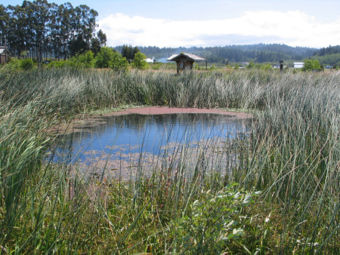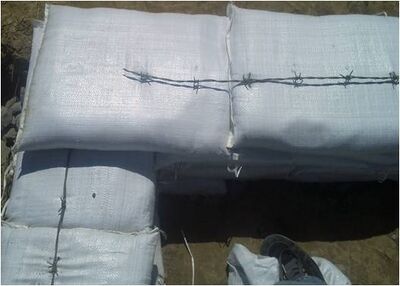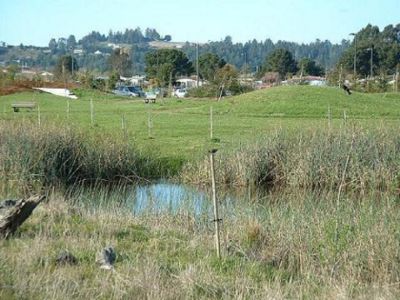Maxosofsky (talk | contribs) No edit summary |
Maxosofsky (talk | contribs) mNo edit summary |
||
| Line 9: | Line 9: | ||
== Design - How It Works == | == Design - How It Works == | ||
[[Potawot swales]] channel storm water directly into the treatment pond. The water travels both above the ground surface and below. As the water reaches the pond, aerobic treatment begins on the surface. At the bottom of the pond, metals collect and are treated anaerobically. [ | [[Potawot swales]] channel storm water directly into the treatment pond. The water travels both above the ground surface and below. As the water reaches the pond, aerobic treatment begins on the surface. At the bottom of the pond, metals collect and are treated anaerobically. <ref name="Eric"/>[2] | ||
The pond's center is the deepest point. the edges are extremely shallow to allow plants to grow naturally there. This is so that the water gets circulated through plant matter on the outer part of the pond, treatment occurs. This circulation is called the "fetch." Bacteria thrive on the parts of the plants that are submerged in the pond. These bacteria eat and digest the toxins. This process successfully decontaminates the water over time. | The pond's center is the deepest point. the edges are extremely shallow to allow plants to grow naturally there. This is so that the water gets circulated through plant matter on the outer part of the pond, treatment occurs. This circulation is called the "fetch." Bacteria thrive on the parts of the plants that are submerged in the pond. These bacteria eat and digest the toxins. This process successfully decontaminates the water over time. <ref name="Eric"/> | ||
Plants that are used in the treatment pond include: | Plants that are used in the treatment pond include: | ||
| Line 37: | Line 37: | ||
- Potamogeton Natans (Floating-Leaved Pondweed) | - Potamogeton Natans (Floating-Leaved Pondweed) | ||
- Nuphar Polysepalum (Yellow Pond-Lily) | - Nuphar Polysepalum (Yellow Pond-Lily) <ref name="Eric"/> | ||
Cleaned water is pumped into a box which rests half-submerged in the pond. This moves the water to a culvert that dumps into the [[Storm water - Seasonal Wetlands]] of [[Potawot]] where it is reintroduced to the natural ecosystem. | Cleaned water is pumped into a box which rests half-submerged in the pond. This moves the water to a culvert that dumps into the [[Storm water - Seasonal Wetlands]] of [[Potawot]] where it is reintroduced to the natural ecosystem. <ref name="Eric"/> | ||
The pond was designed with Franciscan Mirage (or "blue glue"), a hard clay. This clay layer acts as a barrier under the pond, soil, and vegetation to prevent toxins from escaping the area. The picture to the right shows excavation done before laying the clay layer. | The pond was designed with Franciscan Mirage (or "blue glue"), a hard clay. This clay layer acts as a barrier under the pond, soil, and vegetation to prevent toxins from escaping the area. The picture to the right shows excavation done before laying the clay layer. <ref name="Eric"/> | ||
== Location - Potawot == | == Location - Potawot == | ||
Revision as of 03:12, 12 December 2008
Treatment Pond - Purpose

As a part of a much larger storm water treatment system at Potawot, the stormwater treatment pond [FIG 1] treats 100 percent of the water that is channeled into the system. This water comes from parking lot and building runoff from storms. The water is anything but ready to be reintroduced to the ecosystem. The pond's first purpose is to filter the water in a natural way. The pond acts as a natural sponge by removing toxins without harming the environment. Then the water can be reintroduced to the Storm water - Seasonal Wetlands through a culvert. [1][2]
The second purpose of the treatment pond is to encourage natural habitat. The pond's design includes raised islands which create a resting place for water fowl. It is also home to the Three Spine Stickleback Fish, which is indigenous to Humboldt County. Two other indigenous species that the pond is home to are the Red Legged Tree-Frog and the Western Frog. This is to promote sustainability of the environment at Potawot. [1]
Design - How It Works
Potawot swales channel storm water directly into the treatment pond. The water travels both above the ground surface and below. As the water reaches the pond, aerobic treatment begins on the surface. At the bottom of the pond, metals collect and are treated anaerobically. [1][2]
The pond's center is the deepest point. the edges are extremely shallow to allow plants to grow naturally there. This is so that the water gets circulated through plant matter on the outer part of the pond, treatment occurs. This circulation is called the "fetch." Bacteria thrive on the parts of the plants that are submerged in the pond. These bacteria eat and digest the toxins. This process successfully decontaminates the water over time. [1]
Plants that are used in the treatment pond include:
- Scirpus Microcarpus (Small Fruited Bulrush)
- Scirpus Acutus (Soft Stemmed Bulrush)
- Carex Obnupta (Slough Sedge)

- Juncus Effuses (Juncus)
- Aleopecirous Geniculatus (Water Foxtail)
- Glyceria Occidentalis ( Western Manna Grass)
- Equisetum Hymale (Scouring Sedge)
- Mimulus Gutatus (Yellow Monkeyflower)
- Salix (Willow; various species)
- Spirea Douglasii (Hardhack)
- Potamogeton Natans (Floating-Leaved Pondweed)
- Nuphar Polysepalum (Yellow Pond-Lily) [1]
Cleaned water is pumped into a box which rests half-submerged in the pond. This moves the water to a culvert that dumps into the Storm water - Seasonal Wetlands of Potawot where it is reintroduced to the natural ecosystem. [1]
The pond was designed with Franciscan Mirage (or "blue glue"), a hard clay. This clay layer acts as a barrier under the pond, soil, and vegetation to prevent toxins from escaping the area. The picture to the right shows excavation done before laying the clay layer. [1]
Location - Potawot

Potawot is located in Arcata, CA (Humboldt County) on a 40 acre site adjacent to Mad River Community Hospital. The Stormwater Treatment Pond is located behind the main health center complex, just before the wetlands.The map [FIG 3] highlights in red the pond.[2]